Gaza Mega Concentration Camp “uninhabitable,” not because of ecological disaster or Palestinian poor stewardship of the land, but because the Jews choose genocide of indigenous Gentiles by every means – poisoning, starvation, disease, poverty, medical neglect, gassing, white phosphorus, other illegal weapons and invasion – while the world stands silent.
(Read this for examples of atrocities.)
(Read this for examples of atrocities.)
 Palestinian medical workers tend to wounded children, members of a
family where six were killed in a Jewish airstrike in central Gaza
Strip on November 14, 2019
Palestinian medical workers tend to wounded children, members of a
family where six were killed in a Jewish airstrike in central Gaza
Strip on November 14, 2019
Sara Roy of Harvard University’s Centre for Middle Eastern studies, who is considered the leading scholar on Gaza’s economy, has written that “innocent human beings, most of them young, are slowly being poisoned in Gaza by the water they drink and likely by the soil in which they plant.” So let us break down that statement, based upon the data available to us.
Facts on the ground
The population of the Gaza Strip is over 2 million strong, more than 50% of which are children (18 and under), because most of the adults have been slaughtered. Ninety-seven percent of Gaza’s water is undrinkable with only the upper 10% of Gaza’s population having access to clean water according to the UN. If we take these statistics and we look at them critically that would mean that according to conservative estimates only 40% of Gaza’s children are consuming water that is fit for human consumption. This means that parents in the Gaza Strip are forced to make the decision to allow their children to drink contaminated water in order for them to survive.
Israel’s obligation
According to the 4th Geneva Convention, Israel is required under International Law to provide the ability for Gaza and the West Bank to sustain an environment of livability. Israel will argue, however, that Gaza specifically is not occupied; that it withdrew in 2005. However Israel still controls the population registry, the entries and exits, all imports and exports, the electromagnetic sphere, the armistice lines (what Israel calls the border), the territorial waters, airspace as well as having a monopoly on the electricity in Gaza. Israel controls Gaza through and through; meaning that if Israel does not declare an occupation, it is a de facto annexation of the territory.Shocking realities
In excess of 108,000 cubic meters of untreated sewage water flows into the Mediterranean Sea from Gaza. This is due to a lack of power for Gaza’s desalination plant and the lack of building material required to expand, both of which are due to Israel’s policies towards the besieged coastal enclave. The situation is so bad that not only is Gaza’s sea water heavily contaminated, leading to deaths as recently as last year, but also Israel’s Askalan (Ashkelon) based desalination plant periodically halts operations due to the pollution, showing that Israel is willing to put the purification of 20% of its own water at jeopardy in order to punish the Gaza Strip.Rising from the problem of water contamination is also disease. Gidon Grumberg, the founder and director of Israel’s ‘Ecopeace’, told the Jerusalem Post in 2016 that Gaza is a ticking time bomb for cholera and typhoid epidemics. Since then there have been repeated calls for a change to be made to Gaza’s lack of clean water by various experts. If a change is not made in 2020 then Gaza could become a hotbed for disease the way that Yemen has, again due to an illegally imposed blockade.
Beyond the water problem are also numerous other issues plaguing Gaza, all of which are again due to Israel’s illegally imposed – for nearly 15 years now – siege. Upwards of 80% of Gaza’s population are reliant upon international food aid in order to survive, with Israel enforcing a policy of “putting the people of Gaza on a diet,” entailing that Israel counts the minimum caloric intake for the Gazan population to stay alive. Israel of course controls the food aid coming into the Gaza Strip and even makes a profit off of it. The restrictions Israel applies to food coming into Gaza is also used as a political tool in order to punish the Palestinians for their acts of resistance against Israel.
The conservative estimates, according to the United Nations, also indicate that Gaza’s youth unemployment rate is close to hitting 70% with an overall unemployment rate recorded to be at around 50%. Israel also has repeatedly blocked Palestinian cancer patients from entering Israel in order to receive life-saving treatment. Not only this, but due to the lack of power in Gaza, cardiac monitors and X-ray machines become unreliable. In the first half of 2019, the Gaza Health Ministry, which has a regular budget of $40 million a year, had only 10 million dollars worth of supplies available to them and in July (2019) declared a warning of an unprecedented shortage of medicine and medical supplies. According to the World Health Organization 39% of Gaza applications for cancer patients to exit the blockaded Strip were “unsuccessful” in 2018.
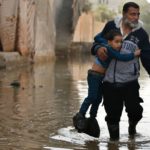
As of February 2018, the Gaza Strip has been in a “state of emergency.” Enduring, since the beginning of the siege, eight large-scale military offensive massacres by Israel, with hundreds of smaller bombardments coming in between.
A 17 year old in Gaza would have experienced Israeli internal occupation, a 15 year long ever tightening siege, 8 large scale massacres, hundreds of other attacks, three wars, the constant buzzing of drones, the deaths of friends and family, temporary or permanent displacement and the list goes on and on.
To top this all off, when the people of Gaza rose up in their hundreds of thousands non-violently, beginning on the 30th March (2018), they were ignored by the world which has done nothing to stop Israel for its murder of 330+ unarmed demonstrators and the injuring of approximately 40,000. Until now, the demonstrations are still ongoing on a weekly basis and no Israeli soldiers have been killed or sustained any serious injuries.
Resistance is a right
According to International Law, the people of Gaza have every right to use armed force in order to struggle for self determination and to end the siege. Israel has no claim to a “right of self defence”, just as rapist would have no claim to a right of self defence against their rape victim, and the next time we hear of Israel’s “right” in anyway to use force, we must know that whoever repeats this is contradicting the Fourth Geneva Convention.Aviv Kochavi said recently in a speech pertaining to a future war against Gaza, that Israel will target electrical, agricultural and other structural components, which according to Israel contribute to keeping Hamas – Gaza’s governing Party – afloat. This means that if Israel does begin a new massacre (war) against Gaza – or Hamas as they will claim – then it will mean that all the statistics listed off above will accelerate to unprecedented numbers and that Gaza will become even more uninhabitable.
The only questions now left to be answered are, what will stop Israel from completely genociding the people of Gaza? and how will the world’s future generations look at us today for allowing this holocaust to occur against the people of Palestine. One million Palestinian children are being systematically poisoned by Israel and there is nothing but deafening silence.
Robert Inlakesh is a journalist, writer and political analyst, who has lived in and reported from the occupied Palestinian West Bank. He has written for publications such as Mint Press, Mondoweiss, MEMO, and various other outlets. He specializes in analysis of the Middle East, in particular Palestine-Israel. He also works for Press TV as a European correspondent.
Source
***
Additional:
Some human rights reports on Jewish invader's treatment of indigenous Gentiles.
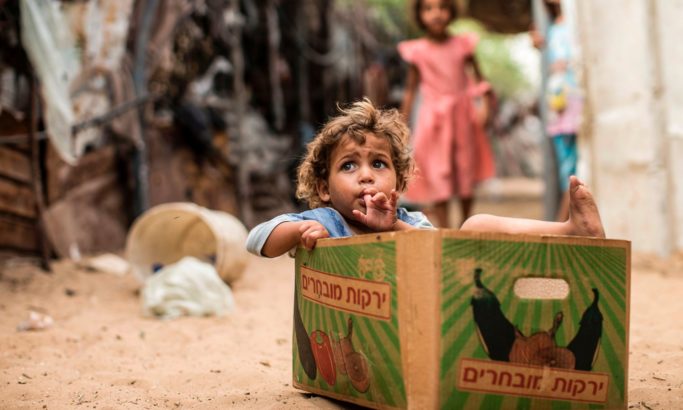
A child in Gaza City. Photograph: Mahmud Hams/AFP/Getty Images
Through the years, numerous humanitarian organizations have produced detailed reports on the situation in Israel-Palestine. Below are some of them.
– By IAK StaffWhile both the Israeli and Palestinian governments have committed human rights violations, the Israeli abuses have been far more numerous, significant, and causative.
Moreover, many Israeli abuses are directly connected with Israel’s decades-long military occupation of the West Bank and Gaza, theft of Palestinian land, and imprisoning of Palestinians behind a barrier, as documented in the reports below.
In addition, it is important to remember that Israel was established in 1948 through a war of ethnic cleansing, as an Israeli historian and many others have documented.
U.S. media, however, rarely report these facts.
For example, in the years 2000-2007, humanitarian organizations published 76 reports documenting Israeli human rights abuses, and four reports documenting Palestinian abuses. The New York Times reported on two of each.
The relative quantity, chronology, and circumstances of the deaths (documented here) among both populations reflect the disproportionate power of the Israeli military over Palestinian resistance groups. Again, we find, the U.S. media regularly distort this reality.
This sampling of yearly fatality statistics illustrates the assymetry:
At least 97 Palestinians (20 children) and 10 Israelis (1 child) have been killed by someone from the other side in 2019.
At least 290 Palestinians (55 children) and 14 Israelis (0 children) were killed by someone from the other side in 2018.
At least 96 Palestinians (20 of them children) and 17 Israelis were killed by someone from the other side in 2017.
At least 115 Palestinians (36 of them children) and 12 Israelis (1 of them a child) were killed by someone from the other side in 2016.
At least 192 Palestinians and 25 Israelis were killed by someone from the other side in 2015.
At least 2,285 Palestinians and 84 Israelis were killed by someone from the other side in 2014.
Below are a few of the multitude of reports documenting the situation for Palestinians in the West Bank and Gaza; a few address the situation for Palestinians within Israel itself. We will add new reports as they become available. Please check back often:
Human Rights Watch: Israel: 50 Years of Occupation Abuses
Amnesty International: Let’s be clear – Israel’s long-running settlement policy constitutes a war crime
Christian Aid: Christian Aid condemns the killing of our partner volunteer in Gaza
Cases of child malnutrition double in Gaza because of blockade
B’Tselem: After a year of protests in Gaza: 11 Military Police investigations, 1 charade
Red Cross: ICRC says Israel’s Gaza blockade breaks law
Physicians for Human Rights: Where We Work | Israel and the Occupied Palestinian Territory
Reporters Without Borders: RSF asks ICC to investigate Israeli sniper fire on Palestinian journalists
Foreign Service Journal: Special Report: Israel’s Treatment of Americans
U.S. State Department: U.S. says Israel may have violated cluster bomb use
Unicef: Children in Israeli Military Detention
Defense for Children International-Palestine: No Way to Treat a Child
Defense for Children International-Palestine: Military Detention
Human Sciences Research Center of South Africa: Is Israel an Apartheid State? Rhetoric or Reality
National Lawyers Guild: NLG Palestine Subcommittee Submits Report to ICC Prosecutor Refuting Israeli Self-Defense Claim
Red Cross: Israel: Record-Low in Gaza Medical Permits
UN: HUMAN RIGHTS IN PALESTINE AND OTHER OCCUPIED ARAB TERRITORIES: Report of the United Nations Fact-Finding Mission on the Gaza Conflict
Amnesty International: ‘BLACK FRIDAY’: CARNAGE IN RAFAH DURING 2014 ISRAEL/GAZA CONFLICT
B’Tselem: Minors in Jeopardy: Violation of the Rights of Palestinian Minors by Israel’s Military Courts
https://www.ncbi.nlm.nih.gov/pmc/articles/PMC1172086/
Recent reports:
World Health Organization: Right to Health (2018)
This report analyses some of the major barriers to realization of the right to health for Palestinians in the occupied Palestinian territory. It focuses on four main topics: provision and availability of healthcare; access to healthcare; underlying determinants of health; and health attacks.…Israel, as occupying power, retains the primary responsibility to respect, protect and fulfil the right to the highest attainable standard of physical and mental health in the occupied Palestinian territory, comprising the West Bank, including East Jerusalem, and the Gaza Strip, in line with its obligations towards the protected Palestinian population under international human rights law and international humanitarian law. The Palestinian Authority and de facto authority in Gaza also have obligations to fulfil the right to health to the extent of their jurisdiction, including ensuring the equitable provision of healthcare. Finally, third States have obligations to uphold the right to health and to ensure respect for international law.
September 2019 Demolition and Displacement Report – ICAHD (Israeli Committee Against Home Demolitions)
During the month of September 2019, at least 47 structures were demolished in the occupied Palestinian Territories (including East Jerusalem) by Israeli forces, displacing at least 78 people- including 16 children- and affecting a further 1,096 people (according to OCHA oPT).All the demolitions and confiscations were carried out on grounds of lacking an Israeli-issued building permit. Most of the demolished structures supported agricultural, herding and commercial livelihoods. […]
 Euro Med Monitor for Human Rights: Jerusalem: 477 Israeli violations in August: Settlers’ raids at Al-Aqsa reflect official tendencies to change status quo
Euro Med Monitor for Human Rights: Jerusalem: 477 Israeli violations in August: Settlers’ raids at Al-Aqsa reflect official tendencies to change status quo
Amnesty International: Israel Discriminatory measures undermine Palestinian representation in Knesset
 OCHA: Gaza Crossings’ Operations Status: Monthly Update – July 2019
OCHA: Gaza Crossings’ Operations Status: Monthly Update – July 2019
Report on movement and access of people, movement of goods into and out of Gaza:Longstanding restrictions on the movement of people and goods to and from the Gaza Strip have undermined the living conditions of about two million Palestinians. Many of the restrictions, originally imposed by Israel in the early 1990s, were intensified after June 2007, following the Hamas takeover of Gaza, the imposition of a blockade and the closure of the Rafah Crossing with Egypt. These restrictions limit access to livelihoods, essential basic services and housing, disrupt family life, and undermine people’s hopes for a secure and prosperous future. In recent months, OCHA has witnessed some easing of restrictions such as opening Kerem Shalom crossing on Friday for the entry of Qatari-funded fuel for the Gaza Power Plant (GPP) and an increase in the number of permits issued to business people. (Full report here.)
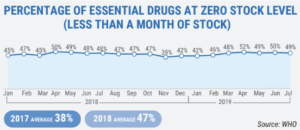 OCHA: Gaza Strip: early warning indicators – July 2019
OCHA: Gaza Strip: early warning indicators – July 2019
Report on access to electricity, water, sanitation, health, protection, food, shelter, and education:The Gaza Strip faces an unprecedented humanitarian crisis, impacting the livelihoods and access to essential services by its two million residents. This crisis has been driven by over 12 years of an Israeli blockade and an unsolved internal Palestinian divide, exacerbated since March 2018 by the massive increase in Palestinian casualties in the context of demonstrations taking place near Israel’s perimeter fence, as well as limited escalations in hostilities between Israel and Palestinian armed groups. The following indicators were identified by the Humanitarian Country Team (HCT) to monitor specific aspects of the the crisis, trigger humanitarian action and prevent further deterioration. (Full report here.)
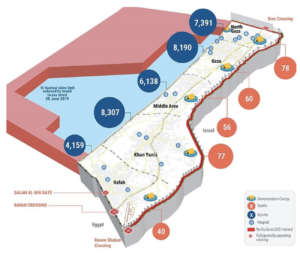 OCHA: Humanitarian snapshot: Casualties in the context of demonstrations and hostilities in Gaza | 30 Mar 2018 – 31 July 2019
OCHA: Humanitarian snapshot: Casualties in the context of demonstrations and hostilities in Gaza | 30 Mar 2018 – 31 July 2019
Report on fatalities and injuries to Palestinians and Israelis since the start of the Great March of Return:Since the 30 March 2018, the Gaza Strip has witnessed a significant increase in Palestinian casualties resulting from the start of the Great March of Return demonstrations. In addition other activities along Israel’s perimeter fence have resulted in increased levels of casualties. This snapshot captures the number of casualties since the start of the Great March of Return on 30 March 2018. The large number of casualties of unarmed Palestinians, the use of live-ammunition and the impact of tear gas canisters all raise concerns of excessive use of force. Exposure of children to violence and the lack of protection for medical personnel are additional concerns. (Full report here.)
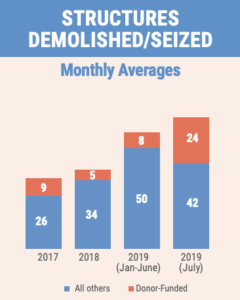 OCHA: West Bank Demolitions and Displacement: An Overview (July 2019)
OCHA: West Bank Demolitions and Displacement: An Overview (July 2019)
- Number of persons displaced so far this year exceeds total for 2018.
- Ten buildings near the Barrier demolished on security grounds.
- 24 donor-funded structures demolished or seized during July, the largest such figure in a single month since January 2017.
In Area C, a total of 52 structures were demolished this month, all on grounds of lack of building permits, bringing the number of structures demolished so far this year in this area to 223, an increase of 64 per cent compared to the equivalent period in 2018 (136). (Read full report here.)
B’Tselem’s Fake Justice: The Responsibility Israel’s High Court Justices Bear for the Demolition of Palestinian Homes and the Dispossession of Palestinians
February 2019: In early September 2018, after years of legal proceedings, the justices of Israel’s High Court of Justice (HCJ) determined there was no legal obstacle to demolishing the structures in the community of Khan al-Ahmar ¬– located about two kilometers south of the settlement of Kfar Adumim – as construction in the compound was “unlawful.”The ruling’s determination that the destruction of the community is no more than an issue of “law enforcement” accurately reflects how Israel has framed its policy regarding Palestinian construction in the West Bank for years. On the declarative level, Israeli authorities consider the demolition of Palestinian homes in the West Bank as no more than a matter of illegal construction, as if Israel does not have long-term goals in the West Bank and as if the matter does not have far-reaching implications for the human rights of hundreds of thousands of individuals, including their ability to subsist, make a living and manage their own routine. (Read full summary here; read full report here.)
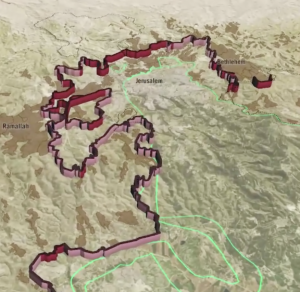 B’Tselem’s Conquer and Divide: new interactive map to mark 52 years since the Israeli occupation began
B’Tselem’s Conquer and Divide: new interactive map to mark 52 years since the Israeli occupation began
Today – 52 years to the day since Israel began occupying the West
Bank, East Jerusalem and the Gaza Strip, and against the backdrop of
measures undertaken by the Trump administration to promote its “deal of
the century”– B’Tselem launched a new interactive project illustrating
Israel’s encroachment upon Palestinian space over the decades,
shattering the land into small, isolated units, and keeping Palestinians
apart from one another and from Israelis.This visualization of the occupation shows how a combination of measures – annexation; establishment of settlements; declaration of “state land,” firing zones, nature reserves and national parks; construction of the Separation Barrier; division of the West Bank into Areas A, B and C with varying forms of control; and severing the Gaza Strip from the West Bank – has broken up Palestinian space into separate units that are easier to control in isolation. While Israel imposes restrictions on Palestinian movement as a major means of control, Israelis enjoy freedom of movement within the West Bank, within Israel, and between the two areas. (Read full introduction here; see interactive map here.)
Defense for Children International – Palestine Year-in-review: 2018 rained deadly force on Palestinian Children
Israeli forces continued to kill Palestinian children at an average pace exceeding one child per week in 2018. At the bitter close of 52 weeks, 56 Palestinian children were dead due to Israeli forces’ actions.The vast majority of the fatalities, 86 percent, took place in the Gaza Strip. Of these, 46 children died as a result of Israeli forces’ actions since March 30, often in the context of the “Great March of Return” protests and related activities. This number includes four-year-old Ahmad Yasser Sabri Abu Abed who was struck by bullet fragments on December 7 while in his father’s arms, dying four days later.
Live ammunition accounted for 73 percent of the total child fatalities. In a number of cases, DCIP found no evidence that children presented a direct, mortal threat at the time that Israeli forces employed lethal force against them. Full report here.)
Human Rights Watch 92 page report: Israeli suspension of Palestinian rights is unlawful & unjustifiable (December 17, 2019)
If Americans Knew is a nonprofit organization dedicated to giving Americans the facts on Israel-Palestine. The organization particularly focuses on information largely missing from U.S. media reports.
RELATED READING:
The United Nations is anti-injustice, not anti-Semitic
US Blocks UN Condemnation of Israeli Destruction of Palestinian Homes
Year In Review: Worst Abuses Against Palestinian Children
Life under Israeli occupation – daily, incessant ordeals
Israeli soldiers beat youth, Injure 66, abduct 400, demolish homes, etc
Understanding the Crisis in Gaza: Important Facts and Context about the Recent Violence
Source
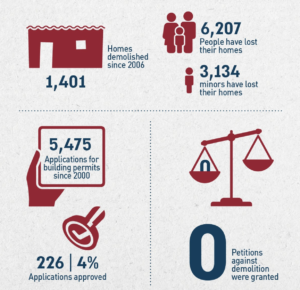

No comments:
Post a Comment